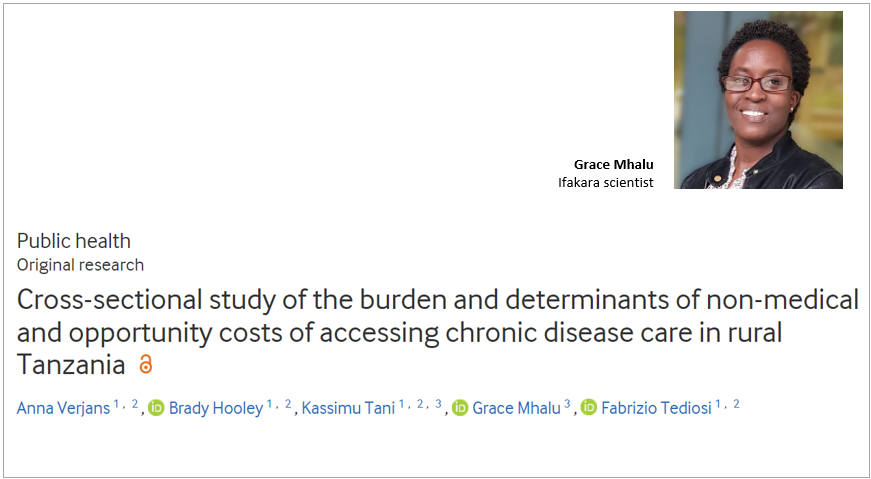
HEALTH ECONOMICS: High non-medical costs for chronic disease patients in Tanzania

Access to healthcare remains a pressing issue globally, particularly in regions like sub-Saharan Africa. In Tanzania, efforts to improve healthcare access through health insurance have been ongoing, but a recent study highlights the challenges faced by patients, especially those with chronic diseases (CDs).
Published on the BMJ Open journal, the study, conducted by scientists from the Swiss TPH and Ifakara Health Institute, investigated the financial burdens faced by patients with chronic conditions in Tanzania when seeking healthcare.
Conducted between November 2020 and January 2021 in rural Same and Kilombero districts, the study shows how the costs of accessing healthcare often exceed the minimum daily income, increasing challenges for patients.
The study aimed to analyze non-medical costs associated with accessing healthcare faced by patients with chronic conditions in rural Tanzania while identifying the underlying factors causing these financial burdens.
Thousands of patients surveyed
After surveying thousands of patients across 35 healthcare facilities, the study revealed that out of 1,748 participants, 534 had at least one chronic disease, with 20% experiencing comorbidities. The study, which considered a minimum hourly income of US$0.22 and 9 working hours per day, revealed that patients incur non-medical costs equivalent to 114% of the minimum daily income.
These costs, averaging US$2.26 per patient, cover various expenses such as travel and time spent at healthcare facilities. However, patients with CDs incurred significantly higher non-medical costs than others, averaging at US$2.79, compared to US$2.03 for non-CD patients. Furthermore, CD patients faced a monthly illness-related opportunity cost of US$10.19, ranging from US$0 to US$59.34.
“Patients with NCD incurred significantly higher direct, indirect and total costs relative to other patients. Furthermore, patients with comorbid chronic conditions spend more time seeking care compared with those with one condition and in turn bear higher opportunity costs,” reported the scientists.
Key factors driving costs
According to the scientists, some of the key factors contributing to higher non-medical costs included having multimorbidities, hypertension, being covered by health insurance, and seeking care at hospitals rather than other facilities.
Patients with chronic conditions, such as cardiovascular diseases and HIV, were found to bear the burden of these non-medical costs due to the need for frequent visits to healthcare facilities and the often unavailability of essential medicines.
Role of insurance
The study also highlights the role of health insurance status on the cost burden, with insured individuals experiencing contrasting effects on travel and time costs. While insured patients face lower travel costs, they often encounter longer waiting times at crowded hospitals, leading to higher time costs.
“Our study revealed that health insurance status has contrasting effects on direct and indirect non-medical cost, with a non-significant negative association with travel cost and a strongly significant positive association with time cost, both with the travel and clinic time.”
“This could result from the fact that a higher proportion of insured people seek care at the hospital. Since there are only a few hospitals, most people would have to travel further to reach them. In addition, they are often more crowded, leading to longer waiting times and higher time costs.”
Conclusion and policy implications
In conclusion, the scientists underscore the substantial financial burden faced by CD patients seeking outpatient care in Tanzania, despite health insurance coverage.
To lessen the burden, they recommend policy interventions aimed at enhancing the availability and quality of CD care in dispensaries and health centers, aiming to reduce financial pressures on patients.
“Outpatient care in Tanzania imposes considerable non-medical costs, particularly for people with CDs, besides illness-related opportunity costs. Despite having health insurance, patients with CDs who seek outpatient care in hospitals face higher financial burdens than other patients. Policies to improve the availability and quality of CD care in dispensaries and health centers could reduce these costs.”
Author’s contribution
This study was conducted by Anna Verjans and Brady Hooley, co-leading authors from Swiss TPH, in partnership with Fabriziaio Tediosi, also from the Swiss TPH, along with Kassimu Tani and Grace Mhalu from the Ifakara Health Institute.
Read the publication here.
